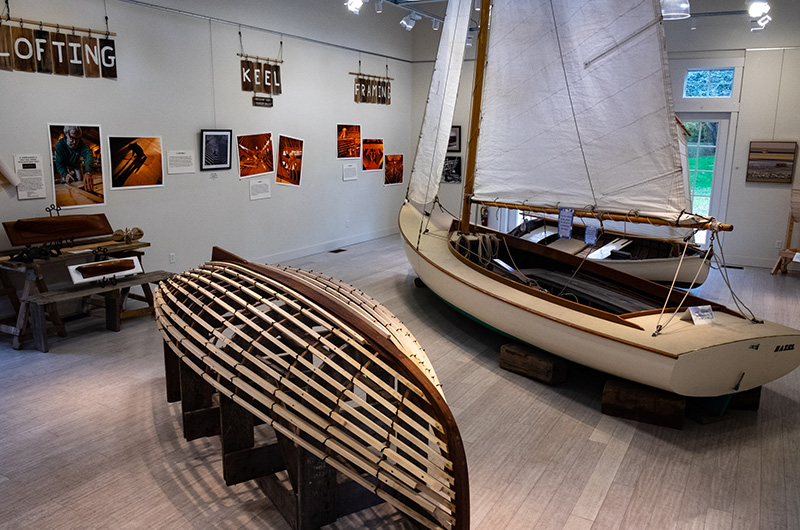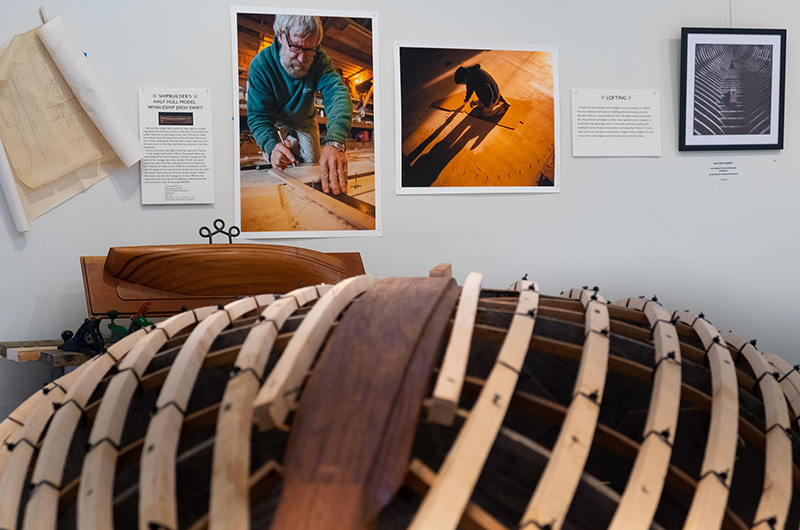Rat said to Mole, in that memorable passage from Wind in the Willows, “there is nothing — absolutely nothing — half so much worth doing as simply messing about in boats.”
Fortunately, on Martha’s Vineyard there are plenty of artistic people who agree with Rat, and some of them have put together a show at Featherstone Center for the Arts.
You could do a lot worse than messing around at The Art of Boatbuilding, on display at Featherstone through Nov. 11. It is absolutely worth doing.
The exhibit is curated by boat builder Nat Benjamin, photographer Alison Shaw, and author Tom Dunlop. Mr. Benjamin, with his boat-building partner Ross Gannon, has created many dozens of works of art that also happen to sail beautifully, from his Vineyard Haven boat yard. Ms. Shaw and Mr. Dunlop collaborated on the classic book Schooner, written about the building of the 60-foot wooden schooner Rebecca on Martha’s Vineyard.
All three curators singled out Featherstone gallery manager Kate Hancock for her vision and organization in creating the show.
Mr. Dunlop said the art on display pays homage to a long history of boat building on the Island.
“On a coastline, the Eastern seaboard where so many boat shops are closed down, and the waterfront has been given over to hotels and recreation, this place has an unbroken record of boat building, traditional and modern, that goes back probably to the time of the colonial settlers,” Mr. Dunlop said. “That’s really unique. It startled me all over again to think about this remarkable uninterrupted history that we have. It’s one of those things that sets Martha’s Vineyard apart.”
Ms. Shaw said boats have always been a part of her life, but it was a particular commissioned project that hooked her on the design and building part of the process.
“I grew up on boats,” Ms. Shaw said. “I’ve always loved boats. Boat building wasn’t something on my radar, until Bill Graham hired me in 1995 to photograph his boat Maybe Baby. That it was an art project, and not a documentary project was crucial. I fell in love with the art of boat building, the whole ambiance, the process and the visuals, and what it meant. That first boat was really the genesis for me. It was the starting point of what has been a pretty serious pursuit since then.”
Ms. Shaw said the marriage of editorial and art photography has been a gift for her.
“I really enjoy just being a fly on the wall, an observer,” Ms. Shaw said. “And I really enjoy working with available light. Both of those things have been very much present. In a really small area, photographing a fairly small subject matter, and just spending my time getting deeper and deeper, and also look for moments and see how lighting affects the whole scene.”
The display is organized along the chronological order of designing and building a boat. Mr. Benjamin is shown in the warm light of his office, hunched over his drafting table. His boat building partner Ross Gannon is portrayed sprawled out on the floor of a shop, carefully tracing the full scale lines and structure of a boat in a process called lofting. The rest of the process plays out around the new exhibit space, from framing, planking, decking, all the way to the launch celebration.
When Mr. Benjamin sits down at his drafting table, beauty is most definitely on his mind. Some of his original design drawings are on display. There is a lot of science that goes into the drawing, but there is a lot of art, too.
“It’s a combination of the two for sure,” he said. “That’s what I find the most interesting. It’s not just one or the other. It’s a balance.”
It’s a balance, but not a compromise, in Mr. Benjamin’s philosophy of building boats. He takes some inspiration from his mother, who was a sculptor.
“There are sculptural aspects to it, for sure,” Mr. Benjamin said. “When you’re drawing a boat, that’s certainly part of the process, to create a shape above and below the waterline that’s pleasing to the eye and also goes through the water well. I hope I’ve never drawn an ugly boat. I don’t think there’s any reason to. You can make a boat go fast and perform well, and do all those other things and still have it look right and look good.”
It’s rare that art, and the subject of the art, are displayed in the same place, but that’s the case here. In the middle of the hall is a jig, or form, used to build an 11-foot yacht tender. On the other end of the hall is a tender itself, built with the jig. In between them is an 18-foot Gannon and Benjamin day sailer complete with sails flying. The mainsail is reefed, not for the wind, but to fit the gaff rig inside the building.
Perhaps, however, they are not the subject of the show, but integral pieces of art themselves. After all, a wooden boat is as much sculpted as constructed, as much painted and varnished to an artistic sheen as any artist’s canvas.
The Art of Boat Building continues through Nov. 11 at Featherstone Center for the Arts.






Comments (4)
Comments
Comment policy »